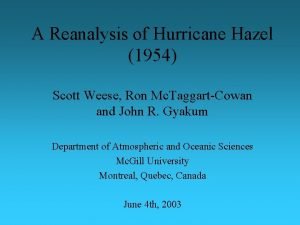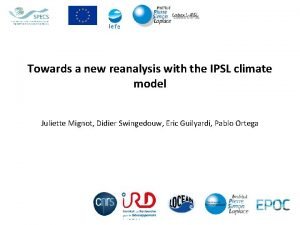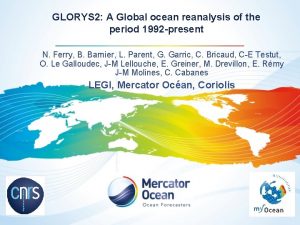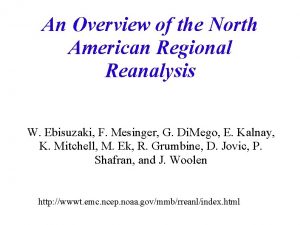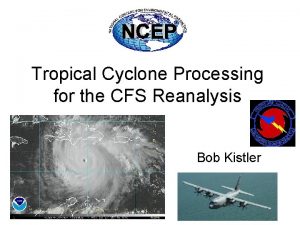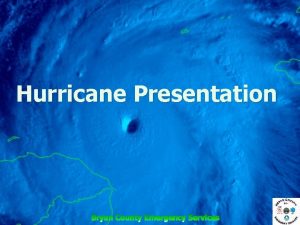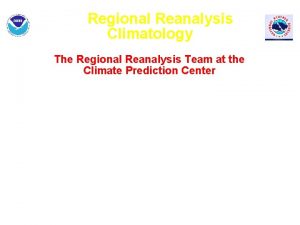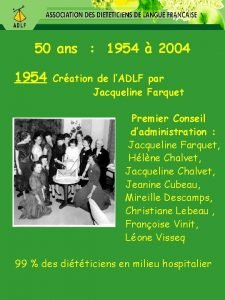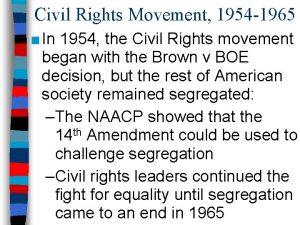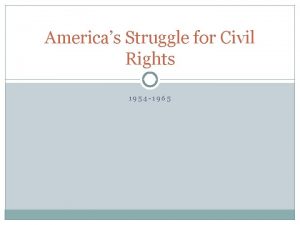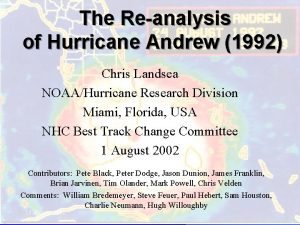A Reanalysis of Hurricane Hazel 1954 Scott Weese

















- Slides: 17

A Reanalysis of Hurricane Hazel (1954) Scott Weese, Ron Mc. Taggart-Cowan and John R. Gyakum Department of Atmospheric and Oceanic Sciences Mc. Gill University Montreal, Quebec, Canada June 4 th, 2003

Talk Outline 1 2 3 4 . . Background Synoptic Overview MC 2 Simulation Results Conclusions

Purpose: to study thermodynamic and dynamic properties of one of the most deadly and costly weather disasters to strike southern Ontario • Hazel struck Ontario on 15 -16 October 1954 • rains led to flooding in Humber, Credit and Don River valleys situated near Toronto, and in the Holland Marsh north of Toronto • over 80 fatalities, and $175 million damage was done by Hurricane Hazel in Ontario

Track of Hurricane Hazel Reference: Mason, A. H. , M. K. Thomas and D. W. Boyd. 1955. The October 15 -16, 1954 Storm, “Hurricane Hazel” in Ontario.

Synoptic Overview • Considering the time between October 15 th at 00 z to October 16 th at 12 z as this is the period of the most intense rainfall in southern Ontario • Using the NCEP reanalysis data (Kalnay et al. 1996) to generate fields of interest

Figs. (a)-(d): SLP (h. Pa) and Thickness (dam) 00 UTC 15 to 12 UTC 16 October

Dynamic Tropopause Maps • The dynamic tropopause is defined as the 1. 5 PVU surface • 1 PVU = 10 -6 m 2 s-1 K kg-1 • Ertel’s Potential Vorticity (PV) (Ertel 1942):

Figs. (a)-(d): DT Winds and q, and 850 h. Pa q 00 UTC 15 to 12 UTC 16 October

Coupling Index, Equivalent Potential Temperature and Precipitable Water • Coupling Index (CI) is a measure of bulk atmospheric stability (Bosart and Lackmann 1995) • Values of CI < 10 suggest convective instability • Precipitable water is the column integrated water vapour

Figs. (a)-(d): Coupling Index and Precip. Water (mm) 00 UTC 15 October to 12 UTC 16 October

MC 2 Simulation • Using MC 2 (Mesoscale Compressible Community Model) to simulate Hazel • NCEP Reanalysis data utilized for the initial and boundary conditions • following the work of Palmen (1958) and Anthes (1990) • test sensitivity of Hazel to improved vortex structure using model by Kurihara (1993), and increased spatial resolution (36 km)

Tracks of Hurricane Hazel

SLP Comparison 15 UTC 15 October top: Palmen’s analysis lower left: MC 2 lower right: Anthes

SLP Comparison 3 UTC 16 October top: Palmen’s analysis lower left: MC 2 lower right: Anthes

Knox’s Jump SLP for 21 UTC 15 October to 03 UTC 16 October

Precipitation Comparison, 15 October

Conclusions • Successfully reproduced transformation of Hazel with accompanying frontogenesis and heavy precipitation over U. S. • Improved vortex structure and increased spatial resolution necessary for successful mesoscale modeling of Hazel
 Hurricane hazel track
Hurricane hazel track Eric guilyardi
Eric guilyardi Glorys reanalysis
Glorys reanalysis North american regional reanalysis
North american regional reanalysis Cfs reanalysis
Cfs reanalysis 1954
1954 Muhammad yusuf maylida kimgadir yoqsa yoqmasa
Muhammad yusuf maylida kimgadir yoqsa yoqmasa Ron hubbard 1954
Ron hubbard 1954 1970-1954
1970-1954 Vietnam 1954
Vietnam 1954 Point o woods old lyme
Point o woods old lyme Godzilla king of the monsters 1954
Godzilla king of the monsters 1954 1954 chevrolet bel air
1954 chevrolet bel air Ruby bridges how old is she
Ruby bridges how old is she Henri matisse portrait of lydia
Henri matisse portrait of lydia 1954-1865
1954-1865 Fortran 1954
Fortran 1954 Incident method
Incident method
